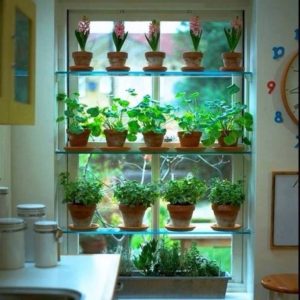While the majority of Americans depend on grocery stores and supermarkets for freshly grown foods; there is an increasing part of the population who has decided to grow at least some of their own food at home. Growers living in urban areas are among them, reaping the fruits, vegetables, and herbs from container gardening.
If you can imagine homegrown organics at your fingertips and want to join the food revolution, here are some tips on beginning the indoor gardening process.
THE INDOOR KITCHEN GARDEN
The biggest challenge when growing vegetables or herbs indoors is growing enough to fulfill your nutritional and culinary needs. For instance, you may want to have basil readily available when preparing your pesto or an endless stream of greens to cook with dinner. The foundations have to be right to get the yields you want.
LOCATION
The windowsill is your obvious first choice to start your indoor garden. If there is not adequate room for potted plants, go vertical. There are many different edible living wall starter kits available on the market which are easy to assemble and are aesthetically pleasing.
THE CONTAINERS
Choose a container whose size fits comfortably on your windowsills or walls, and easy to maintain and matches your decor. The container has to be big enough for the plants’ roots to grow and spread out to produce a bountiful harvest. An oblong window box, usually between 22 to 28 inches long and 6-8 inches wide, or a terra cotta round pot no smaller than 8 inches in diameter, are sufficient sizes to get a window sill organic kitchen garden started.

 For vertical kitchen gardens, you can use a variety of shaped and sized planters, making sure that they’re at the minimum 6-8 inches in diameter.The containers must have holes on the bottom to ensure good drainage. When planting, space the plants out evenly, about 3 inches apart.
For vertical kitchen gardens, you can use a variety of shaped and sized planters, making sure that they’re at the minimum 6-8 inches in diameter.The containers must have holes on the bottom to ensure good drainage. When planting, space the plants out evenly, about 3 inches apart.
You may also buy plastic pots with trays on the bottom and place them inside a fancier wooden window box for a more stylish look. For wall planting, follow the same spacing technique or use single plant sized planters.
THE SOIL
Purchasing a good organic soil is imperative. I like using Pro-mix Premium Organic Vegetable and Herb Mix or Black and Gold Natural and Organic Potting Mix. If you are going to start your plants from seed, start with a seedling soil mix like Pro-Mix Organic Seed Starting Mix or Black and Gold Seedling Mix. Sow seeds in smaller pots, and then transplant the seedling to the container where you want your herbs or other edibles to grow. When choosing edibles to grow, pick what you like to eat and smell. The aromatic qualities of herbs and vegetables are as enticing as their taste.
LIGHTING
‘Grow lights’ are a must for nearly everyone living in an apartment building. If you don’t have wrap around windows, you will need ‘grow lights’, especially during the winter months. Shine your ‘grow lights’ 6 – 12 inches away from and directly on your plants, for at least 6-8 hours a day. ‘Grow lights’ can be purchased in stores or online in an array of shapes and sizes.
Along with ‘grow light’s, an overhead fan set on low or a small fan circulating air around your mini crop mimics outdoor wind and helps with aeration. It imitates nature and assists with preventing mold and deterioration.
WATERING SCHEDULE
Maintaining a consistent watering schedule is essential. Create a routine that coincides or works with your life’s schedule. Delegate the responsibility to family members to water once a week and if the soil on the top dries out about 1/2 an inch in between watering, increase watering to twice a week. One cup to two cups of water is a good measure to start with per pot. If you find that water doesn’t drain out the bottom, increase watering by a cup. Some herbs like basil and mint need more water than herbs such as lavender and rosemary.
Observe signals from your plants that indicate whether you are over watering or under watering. If you see droopy leaves, you are under watering. If you notice fungus spots on leaves or green mildew – algae on the surface soil, you are over-watering.
Given a controlled environment, just about anything can be grown and harvested indoors. With the introduction of over 30 new hybrid herbs and vegetables in 2018, cultivated to have distinct foliage, intense flavors, generous yields, and improved disease resistance; you may want to join in the food revolution. Keep in mind homegrown organic edibles are more economical, better-tasting, beneficial to one’s health and a great family activity. It doesn’t get any better than that.
FOUNDER of THE URBAN GARDEN COMPANION E info@theurbangardencompanion.
E info@theurbangardencompanion.
W www.theurbangardencompanion.
www.instagram.com/theurbangardencompanion
www.facebook.com/urbangardencompanion
 Helena is the founder of The Urban Garden Companion, a multi-media platform that teaches people how to urban garden. As an advocate and spokesperson for “growing” natural—using only time tested, organic practices—her mission is to inspire others to live a sustainable, greener life.
Helena is the founder of The Urban Garden Companion, a multi-media platform that teaches people how to urban garden. As an advocate and spokesperson for “growing” natural—using only time tested, organic practices—her mission is to inspire others to live a sustainable, greener life.














